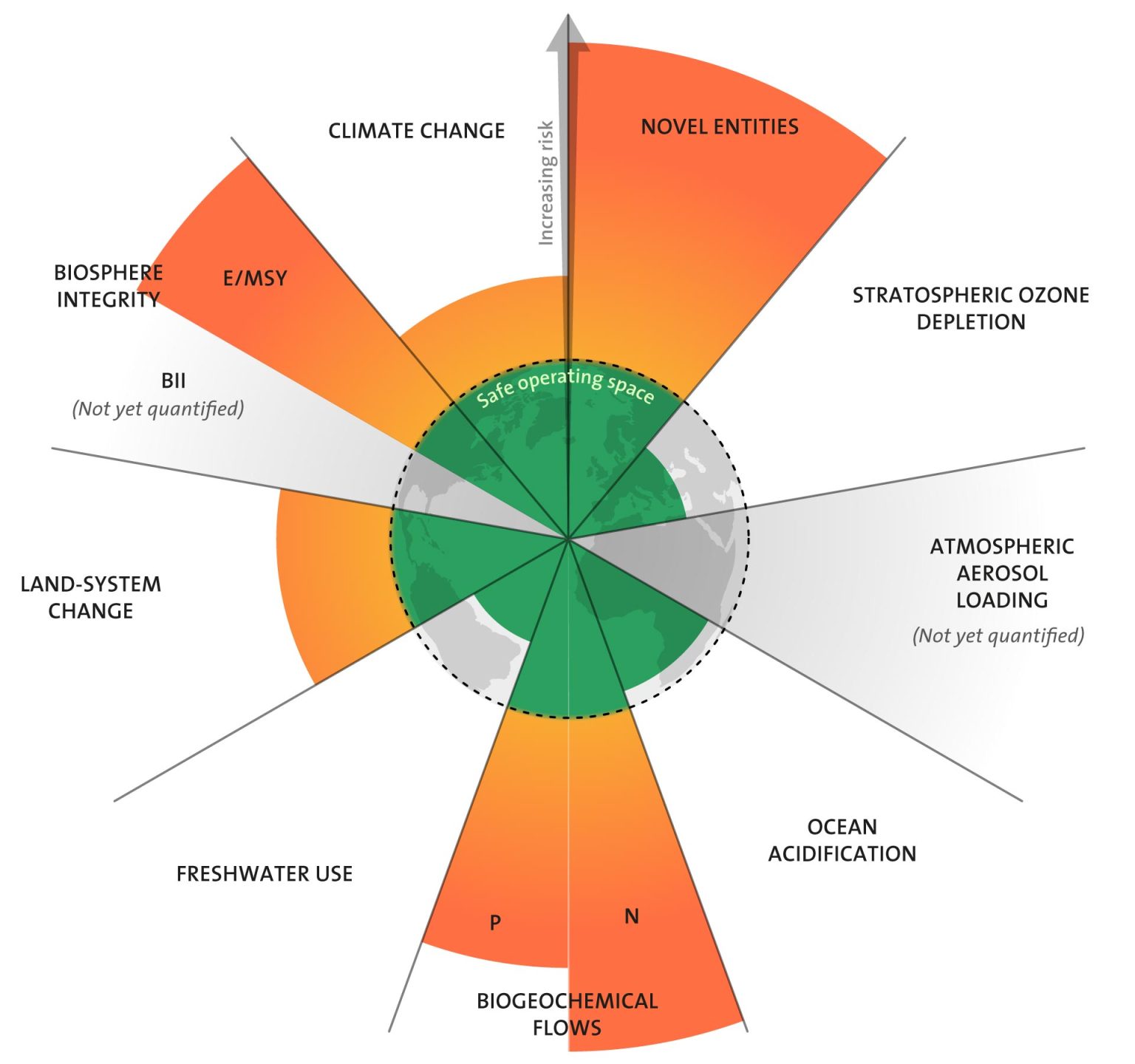Earth’s Safe Planetary Boundary for Pollutants – Including Plastics – Exceeded
By STOCKHOLM RESILIENCE CENTRE

The updated Planetary Boundaries framework (2022) showing 5 boundaries transgressed, now including “novel entities.” Credit: Stockholm Resilience Centre/Azote
First assessment published of planetary boundary related to “novel entities.”
For
the first time, an international team of researchers has assessed the impact on
the stability of the Earth system of the cocktail of synthetic chemicals and
other “novel entities” flooding the environment. The 14 scientists conclude in
the scientific journal Science and Technology that
humanity has exceeded a planetary boundary related to environmental pollutants
including plastics.
“There
has been a 50-fold increase in the production of chemicals since 1950. This is
projected to triple again by 2050,” says co-author Patricia Villarubia-Gómez
from the Stockholm Resilience Centre, Stockholm University. Plastic production
alone increased 79% between 2000 and 2015, the team reports.
“The
pace that societies are producing and releasing new chemicals and other novel
entities into the environment is not consistent with staying within a safe
operating space for humanity,” says Villarubia Gómez.
There
are an estimated 350,000 different types of manufactured chemicals on the
global market. These include plastics, pesticides, industrial chemicals,
chemicals in consumer products, antibiotics, and other pharmaceuticals. These
are all wholly novel entities, created by human activities with largely unknown
effects on the Earth system. Significant volumes of these novel entities enter
the environment each year.
“The rate at which these pollutants are appearing in the environment far exceeds the capacity of governments to assess global and regional risks, let alone control any potential problems,” says co-author Bethanie Carney Almroth from the University of Gothenburg.
The
research fills an important gap in analysis of “planetary boundaries.”
In
2009, an international team of researchers identified nine planetary boundaries
that demarcate the remarkably stable state Earth has remained within for 10,000
years – since the dawn of civilization. These boundaries include greenhouse gas
emissions, the ozone layer, forests, freshwater, and biodiversity. The
researchers quantified the boundaries that influence Earth’s stability, and
concluded in 2015 that four boundaries have been breached. But the boundary for
novel entities was one of two boundaries that remained unquantified. This new
research takes this a step further.
The
researchers say there are many ways that chemicals and plastics have negative
effects on planetary health, from mining, fracking, and drilling to extract raw
materials to production and waste management.
“Some
of these pollutants can be found globally, from the Arctic to Antarctica, and
can be extremely persistent. We have overwhelming evidence of negative impacts
on Earth systems, including biodiversity and biogeochemical cycles,” says
Carney Almroth.
Global
production and consumption of novel entities is set to continue to grow. The
total mass of plastics on the planet is now over twice the mass of all living
mammals, and roughly 80% of all plastics ever produced remain in the
environment. Plastics contain over 10,000 other chemicals, so their
environmental degradation creates new combinations of materials – and
unprecedented environmental hazards. Production of plastics is set to increase
and predictions indicate that the release of plastic pollution to the
environment will rise too, despite huge efforts in many countries to reduce
waste.
“Plastic
production, use, and waste affects other planetary boundaries as well. This
includes climate, via fossil fuel use, land, and fresh water systems via use,
pollution, physical changes, and spread of invasive species, antibiotic
resistance genes and pathogenic microbes in the oceans. Plastics have helped
solve some environmental issues owing to their light weight and durability, but
overuse and misuse is having devastating impacts on planetary health,” says
Carney Almroth.
The
researchers conclude that current increasing trends of chemical production and
release put the health of the Earth system at risk. The authors call for
actions to reduce the production and release of pollutants.
“We
need to be working towards implementing a fixed cap on chemical production and
release,” says Carney Almroth.
“And
shifting to a circular economy is really important. That means changing
materials and products so they can be reused not wasted, designing chemicals
and products for recycling, and much better screening of chemicals for their
safety and sustainability along their whole impact pathway in the Earth
system”, says Villarubia Gómez.
Reference:
“Outside the Safe Operating Space of the Planetary Boundary for Novel Entities”
18 January 2022, Environmental Science & Technology.
DOI: 10.1021/acs.est.1c04158